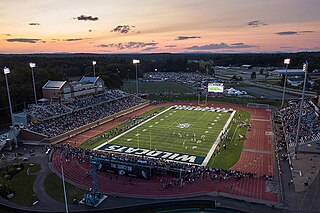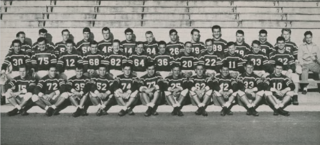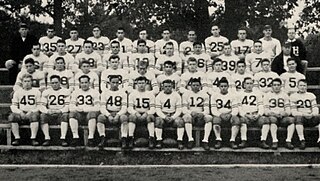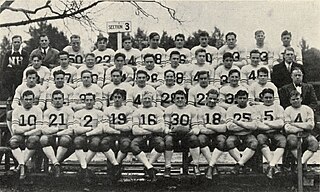
Wildcat Stadium is an 11,015-seat open-air multi-purpose stadium in Durham, New Hampshire, on the campus of the University of New Hampshire (UNH). It is home to the New Hampshire Wildcats football, lacrosse and track and field varsity teams. The stadium, which runs west-northwest, consists of a FieldTurf playing surface surrounded by a 400-metre track. On either side of the track are aluminum stands. The stadium lies just southwest of the Field House, which houses Lundholm Gym as well as Swazey Pool and the Jerry Azumah Performance Center.

The New Hampshire Wildcats football program is the intercollegiate American football team for the University of New Hampshire. The Wildcats compete in the NCAA Division I Football Championship Subdivision (FCS) and are members of the Colonial Athletic Association (CAA). The team plays its home games at the 11,000 seat Wildcat Stadium in Durham, New Hampshire, and are led by head coach Ricky Santos.

The 1925 New Hampshire football team was an American football team that represented the University of New Hampshire as a member of the New England Conference during the 1925 college football season. In its 10th season under head coach William "Butch" Cowell, the team compiled a 4–1–2 record, won the conference championship, and outscored opponents by a total of 91 to 59. The team played its home games in Durham, New Hampshire, at Memorial Field.

The 1944 New Hampshire Wildcats football team represented the University of New Hampshire in the 1944 college football season. The Wildcats were led by first-year head coach Herbert Snow and completed the season with a record of 1–3. The team played its home games at Lewis Field in Durham, New Hampshire.

The 1946 New Hampshire Wildcats football team was an American football team that represented the University of New Hampshire as a member of the Yankee Conference during the 1946 college football season. In its first year under head coach Bill Glassford, the team compiled a 6–1–1 record, outscoring their opponents 161–45. The team played its home games at Lewis Field in Durham, New Hampshire.

The 1942 New Hampshire Wildcats football team was an American football team that represented the University of New Hampshire as a member of the New England Conference during the 1942 college football season. In its first year under head coach Charles M. Justice, the team compiled a 6–0 record, outscoring their opponents 101–46. The team played its home games at Lewis Field in Durham, New Hampshire.

The 1941 New Hampshire Wildcats football team was an American football team that represented the University of New Hampshire as a member of the New England Conference during the 1941 college football season. In its fifth year under head coach George Sauer, the team compiled a 4–3–1 record, outscoring their opponents 153–62.

The 1940 New Hampshire Wildcats football team was an American football team that represented the University of New Hampshire as a member of the New England Conference during the 1940 college football season. In its fourth year under head coach George Sauer, the team compiled a 5–3 record, outscoring their opponents 121–86.

The 1949 New Hampshire Wildcats football team was an American football team that represented the University of New Hampshire as a member of the Yankee Conference during the 1949 college football season. In its first year under head coach Clarence E. "Chief" Boston, the team compiled a 4–4 record, scoring and allowing an equal number of points, 153. The team played its home games at Lewis Field in Durham, New Hampshire.

The 1938 New Hampshire Wildcats football team was an American football team that represented the University of New Hampshire as a member of the New England Conference during the 1938 college football season. In its second year under head coach George Sauer, the team compiled a 3–6 record, being outscored by their opponents 112–42. Each of the team's six losses was by shutout, including all four home games. The team played its home games at Lewis Field in Durham, New Hampshire.

The 1937 New Hampshire Wildcats football team was an American football team that represented the University of New Hampshire as a member of the New England Conference during the 1937 college football season. In its first year under head coach George Sauer, the team compiled a 7–1 record, outscoring their opponents 144–31. Five of the team's wins were by shutout. The team played its home games at Lewis Field in Durham, New Hampshire.

The 1936 New Hampshire Wildcats football team was an American football team that represented the University of New Hampshire as a member of the New England Conference during the 1936 college football season. In its 21st season under head coach William "Butch" Cowell, the team compiled a 3–3–2 record, outscoring their opponents 137–76. The team scored 120 of their points in two shutout wins, and only 17 total points in their other six games. The team played its home games at Lewis Field in Durham, New Hampshire.

The 1935 New Hampshire Wildcats football team was an American football team that represented the University of New Hampshire as a member of the New England Conference during the 1935 college football season. In its 20th season under head coach William "Butch" Cowell, the team compiled a 2–5–1 record, being outscored by their opponents 55–120. The team scored 47 of their points in two shutout wins, and only eight total points in their other six games. All five losses came in away games; the team had two wins and a tie at home. The team played its home games in Durham, New Hampshire, at Memorial Field.

The 1934 New Hampshire Wildcats football team was an American football team that represented the University of New Hampshire as a member of the New England Conference during the 1934 college football season. In its 19th season under head coach William "Butch" Cowell, the team played its home games in Durham, New Hampshire, at Memorial Field. The team compiled a 3–4–2 record, being outscored by their opponents 89–148, while going undefeated at home, registering two wins and two ties in Durham.

The 1932 New Hampshire Wildcats football team was an American football team that represented the University of New Hampshire as a member of the New England Conference during the 1932 college football season. In its 17th season under head coach William "Butch" Cowell, the team played its home games in Durham, New Hampshire, at Memorial Field. The team compiled a 3–4–1 record, and were outscored by their opponents, 110–105. All four losses came in away games, while the team recorded three wins and a tie in Durham.

The 1931 New Hampshire Wildcats football team was an American football team that represented the University of New Hampshire as a member of the New England Conference during the 1931 college football season. In its 16th season under head coach William "Butch" Cowell, the team compiled a 7–2 record, and outscored their opponents, 171–84. The team played its home games in Durham, New Hampshire, at Memorial Field.

The 1930 New Hampshire Wildcats football team was an American football team that represented the University of New Hampshire as a member of the New England Conference during the 1930 college football season. In its 15th season under head coach William "Butch" Cowell, the team compiled a 5–2–1 record, and outscored their opponents, 160–54. The team played its home games in Durham, New Hampshire, at Memorial Field.

The 1929 New Hampshire Wildcats football team was an American football team that represented the University of New Hampshire as a member of the New England Conference during the 1929 college football season. In its 14th season under head coach William "Butch" Cowell, the team compiled a 7–2 record, and outscored their opponents, 162–78. The team played its home games in Durham, New Hampshire, at Memorial Field.

The 1926 New Hampshire Wildcats football team was an American football team that represented the University of New Hampshire as a member of the New England Conference during the 1926 college football season. In its 11th season under head coach William "Butch" Cowell, the team compiled a 4–4 record, and were outscored by their opponents, 90–81. The team played its home games in Durham, New Hampshire, at Memorial Field. This was the first season with Wildcats as the official nickname of the school's sports teams, having been adopted in February 1926.

The 1919 New Hampshire football team was an American football team that represented New Hampshire College of Agriculture and the Mechanic Arts during the 1919 college football season—the school became the University of New Hampshire in 1923. In its fourth season under head coach William "Butch" Cowell, the team compiled a 7–2 record, while outscoring their opponents by a total of 113 to 29. No opponent scored more than seven points against New Hampshire during the season, and the team won four of its games by shutout. This was the first season that the school fielded a freshman football team, in addition to the varsity.




















